Introduction
| |
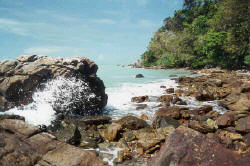 |
| |
Rocky headlands and sandy bays
characterise much of Langkawi's coastline.
|
Off the western coast of Peninsular Malaysia, near the
border with Thailand, lies a group of over 100 stunning tropical islands the
largest of which is Pulau Langkawi. These islands are part of the mainland
Malaysian state of Kedah. Over the last 20 years, under the tutelage of the
Malaysian Prime Minister, Dato' Seri Dr. Mahathir Mohammad, himself born in
Kedah, a tourist industry has developed which has given Langkawi an
international reputation as an unspoiled holiday destination. This
reputation appears well deserved - Langkawi is clean, green and friendly.
Tourist development, on the whole, appears to be as low impact as possible
and the islands still possess uncrowded beaches, thickly forested hillsides
and unpolluted mangroves where monkeys, otters, kingfishers and hornbills
abound.
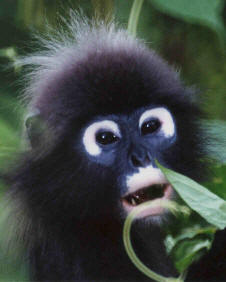 |
|
|
A Dusky Leaf Monkey or
Spectacled Langur Presbytis obscurus feeds on young leaf shoots. |
|
Hey, hey we're the Monkeys
Two species of primate can be found in Langkawi. One
is the ubiquitous Long-tailed or Crab-eating Macaque, Macaca fascicularis,
common throughout Malaysia. The other is the Dusky Leaf Monkey or Spectacled
Langur, Presbytis obscurus. Grey-black in colour, this species is easily
recognised by the white rings around the eyes, which give the animal a
constantly startled expression. During the day, the large social groups
split up into smaller groups of less than 10 individuals which the visitor
can easily see foraging in the lower branches of the forest canopy. In the
late afternoon they may also come to ground level in forest clearings to
feed on the young, tender leaf shoots which make up their diet. As with
other species of Langur, the young have bright orange-brown fur.
| |
 |
| |
The Colugo or Flying Lemur Galeopterus
variegatus. This is probably a grey-coloured female.
|
Flying Lemurs don't fly, and they're not Lemurs
At dusk in forested areas the Colugo or Flying Lemur
Cynocephalus variegatus may be seen. This species suffers from being
mis-named; it is unrelated to the true Lemurs of Madagascar, and it glides
rather than flies ! There are just two species of Flying Lemur worldwide,
the other being the Philippine Flying Lemur; as a result of their ancient
lineage and comb-like teeth both are grouped in the mammalian order of
Dermoptera. These animals are arboreal and nocturnal. The gliding membrane
extends to each body extremity including the tail, giving it a kite-like
shape when gliding. They feed on fruits, flowers and other vegetation.
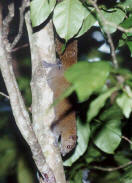 |
|
|
Grey-bellied Squirrel
Callosciurus caniceps
|
|
Other mammals
Other land mammals of note which occur on Langkawi
include the shy Sunda Slow Loris Nycticebus coucang, the arboreal and nocturnal
Marbled Cat Felis marmorata, the rare Greater Mousedeer Tragulus napu,
the Tenggalong or Malay Civet Viverra tangalunga and various species of
squirrel and tree shrew. Footprints believed to belong to the Clouded
Leopard Neofelis nebulosa have also been seen, though the presence of the
species has yet to be confirmed. In mangrove areas the Hairy-nosed Otter
Lutra sumatrana may be seen.
Fly Like an Eagle
| |
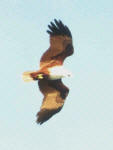 |
|
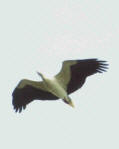 |
| |
Brahminy Kite Haliastur indus
(left) and White-bellied Fish Eagle Haliaeetus leucogaster
|
The skies above Langkawi are dominated by magnificent
Birds of Prey, the most conspicuous of which are the White-bellied Fish
Eagle Haliaeetus leucogaster and the Brahminy Kite Haliastur indus. Both
these species are adept at swooping down and plucking unwary fish from the
shallow, sandy bays. The common, but stunningly attractive
Brahminy Kite with its contrasting white head and breast and brown wings
lends Langkawi part of its name; in Malay "helang" means "eagle". In the
main town of Kuah is a huge statue of this bird about to take flight.
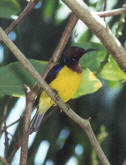 |
|
|
Brown Throated Sunbird (Male)
Anthreptes malacensis
|
|
Langkawi boasts a wide variety of birdlife, situated
as it is near the narrowest part of the Kra Isthmus at the boundary of
Thailand and Malaysia. Migratory birds from North Asia, which migrate south
along the East Asian flyway to spend winter in Indonesia and Australia, will
naturally be funneled through this area. Resident birds include a variety of
Kingfishers which make the northern mangrove areas their home. Most notable
is the rare Brown-winged Kingfisher Halcyon amauroptera, identifiable by its
large size, orange head and breast and its dark brown wings. Most tourists,
however, are more likely to see the brightly coloured sunbirds which
frequent the flowering trees and shrubs in the grounds of their luxury hotel
!
|